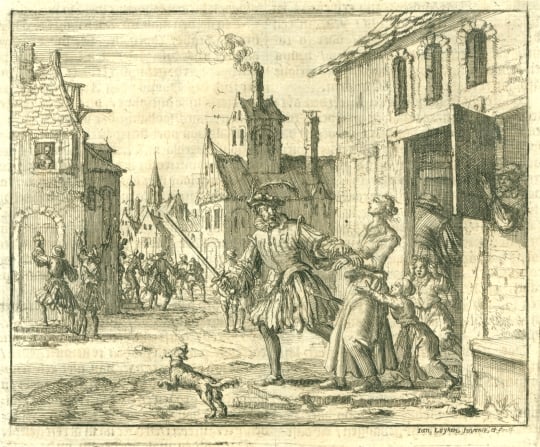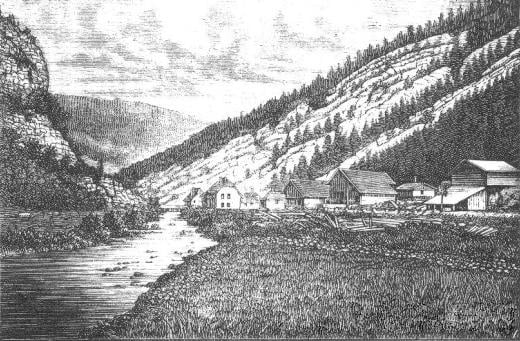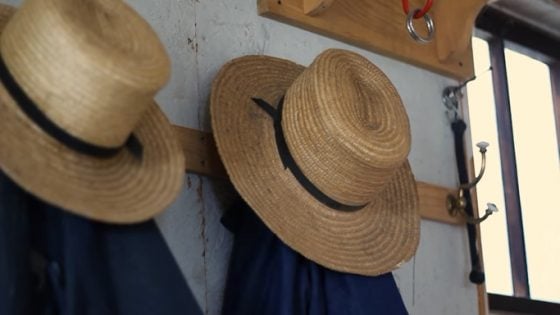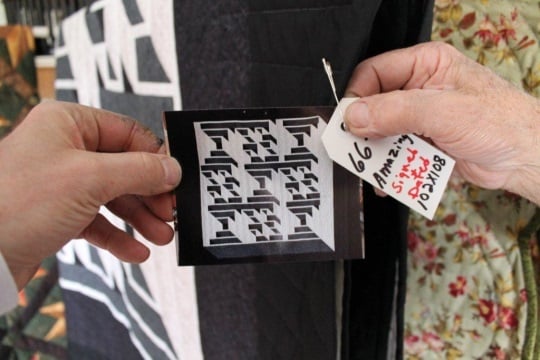John Gingerich on History of the Bernese Anabaptists: Interview and book giveaway
About four years back, Geauga County, Ohio native John Gingerich undertook to translate a text very important to the history of the Amish and other Anabaptists.
 History of the Bernese Anabaptists was written by Ernst Müller and published in 1895. Up until now it has never been available in English.
History of the Bernese Anabaptists was written by Ernst Müller and published in 1895. Up until now it has never been available in English.
In today’s interview, John explains how the translation came about while offering a fascinating look at the story of this important group, including what made them different from other European Anabaptists.
John also discusses their influence on the Amish and other Anabaptist groups today. One of my favorite quotes on that point: “The Bernese Anabaptists were also noted for their hard-headedness. The Amish sometimes joke among themselves that they have inherited this trait!”
More importantly, the Christian martyr tradition of the Bernese Anabaptists lives on in their many descendants today. With the book now available in English a much wider audience will be able to access the story of their forbears.
History of the Bernese Anabaptists book giveaway
 John has also kindly made a copy of the book available for giveaway. To participate, simply leave a question or comment on this post. The winner will be drawn one week from now, on Tuesday, July 12.
John has also kindly made a copy of the book available for giveaway. To participate, simply leave a question or comment on this post. The winner will be drawn one week from now, on Tuesday, July 12.
The book is also available for $10 plus shipping here, where you can also view more info on the book and sample pages.
John Gingerich on History of the Bernese Anabaptists
Amish America: What got you interested in writings on Swiss German Anabaptists?
John Gingerich: My father was raised in an Old Order Amish family in Geauga County, OH. Although he never joined the Church, most of the relatives on that side of the family still belong to the O.O. Amish, or related “plain” churches.
I’ve had an interest in history, especially family history and genealogy, ever since I was very young. I grew up hearing stories about such ancestors as Jacob Hochstettler, who was captured by the Indians, along with his two sons, during the French-Indian war in the 1750’s, and “Der Weis” Jonas Stutzman, another ancestor from Holmes County, OH, who always wore white clothing, as well as many other stories. In fact, I have a chair that was made by “Der Weis” Stutzman.
I soon realized that a person can’t have a good understanding their own family history without having some knowledge of the larger history and events, the context in which their forefathers lived. Thus, I became interested in Amish-Mennonite-Anabaptist history and read quite a bit of material on the subject.
When my last grandparent, Amanda (Schmucker) Gingerich, passed away in 1988, I was given some Testaments, hymnals and prayer books that had belonged to my grandparents and great-grandparents. This led to an interest in the literature of the group, and eventually I began collecting books relating to Amish-Mennonite history. In doing so, I formed many friendships with other book collectors, such as Leroy Beachy in Holmes County, OH, and David Luthy, director of the Old Order Amish Heritage Historical Library in Aylmer, Ontario. By the way, Leroy Beachy just completed his 20-year project, a fascinating, comprehensive book titled Unser Leit (Our People), documenting the history of the Amish.
David Luthy and I became very good friends, and he not only encouraged me in my book collecting endeavors, but we also engaged in many wide-ranging conversations about Amish-Mennonite history. It was during one of these conversations in Feb. 2007 that we had a discussion about the many books significant to Anabaptist history that were originally written in German but never translated into English. David mentioned that there had been a number of attempts over the past two decades to translate the book Geschichte der bernischen Täufer into English, but to no avail. This conversation inspired me to look into translating the book.
Can you share a bit about the importance of this text? How do Amish and other Anabaptists view it today?
John Gingerich: This book is significant because it was the first extensive, objective portrayal of the Anabaptists of Canton Bern that had been written up to that point. Prior books about the group were largely written by their opponents. Since its publication in 1895, the book has frequently been referenced and cited by researchers and historians.
One example of how the book is viewed by Amish and Mennonites today is exemplified by Amos Hoover of the Muddy Creek Farm Library (which houses an extensive collection of documents and books significant to Anabaptist history), who wrote that this book is “the glue in putting our entire collection into one voice,” and he further felt regarding the translation that “there was no book put out in recent history which was so critical to our Swiss Anabaptist heritage.”
What kind of revelations, if any, did you come across that you were not previously aware of?
John Gingerich: I think what impressed me about the early stages of Anabaptism in Switzerland, at the beginning of the Reformation, was how it was such a time of religious experimentation. In freeing themselves from the Catholic Church-State, the early reformers had many discussions, or disputations, about interpretation and application of the Scriptures. Both those who would eventually be persecuted, as well as those who would be persecutors, gathered together to discuss such things as the nature of the Church, its relationship to the State, application of the ban (excommunication), etc. Müller states in his book that it wasn’t certain at one point in time if the Anabaptists wouldn’t actually become the dominant party. Ultimately, however, those in favor of infant baptism and the official State Church relationship dominated the argument.

It would be interesting to conjecture about what would have happened if the Anabaptist view of adult believer’s baptism, separation of Church and State, non-resistance, not swearing an oath, etc, would have held sway. I can think of many scenarios, which would be too much to put into this interview.
What sorts of challenges did Anabaptists in Europe face? Why was Anabaptism seen as a threat? And how did attitudes towards Anabaptists change over time?
John Gingerich: Right from the outset, they were subject to severe persecution, including imprisonment, exile, being sentenced to the galleys, torture, and execution. The rejection of infant baptism itself was viewed as a threat to the established Church-State order, for baptism at birth was not only viewed as joining one to the established Church, but also as one becoming a member of the community and obtaining citizen of the state. Swearing the oath of allegiance was a fundamental part of Swiss citizenship, and refusal to do so was viewed as an abdication of one’s duties to the Fatherland. In addition, not bearing arms, either in personal defense or in fighting for one’s country, was considered seditious.
Gradually, many European States began to allow the Amish and Mennonites to make an affirmation rather than give an oath, and to render some type of alternative service rather than take up arms. The Anabaptists, however, existed in a precarious state, because official toleration of them could change at any time.
The modern-day descendants of the Anabaptists also have a variety of views on these subjects. Although adult believer’s baptism continues to be a central doctrine, some churches no longer promote the principles of non-resistance or not swearing of an oath. Most conservative branches, however, continue to promote these beliefs.

We often read about how the Amish and Mennonites are admired by modern society for their religious, moral, and family values. The Amish were widely hailed for their beliefs about forgiveness after the Nickel Mines shootings.
However, we also recently experienced the other extreme of how their core beliefs are viewed by what happened at Goshen College in the past few months. Although this Mennonite college had quietly adhered to its Anabaptist principles for the past century of its existence, and thus did not play such patriotic songs such as The Star Spangled Banner at sporting events, it reversed this policy in 2010. This created a controversy among students, faculty, and alumni of Amish and Mennonite background. Subsequently, the school’s Board decided recently to revert to its original position, and said it would seek an alternative song.
This has created a national outcry and condemnation by many. No matter one’s position on the issue, I think a person has to understand the historical context in which the Amish, Mennonites, and other Anabaptist groups hold these beliefs. Our forefathers were willing to be imprisoned, tortured, exiled and, in some cases, executed, for these principles. Their strong belief in separation of Church and State, considered radical and traitorous in the 16th century, is now one of our fundamental American values.
Their willingness to nonviolently sacrifice their lives for these beliefs, in my opinion, takes as much courage as someone’s willingness to do the same while fighting for their country.
What distinguished the Bernese Anabaptists from others?
John Gingerich: Unlike Canton Zurich, which succeeded in virtually eradicating its Anabaptists through intense persecution, Canton Bern was never able to completely rid itself of the Anabaptists. In fact, the oldest “Taufgesinnten” Church, formed in 1530, still exists to this day in Canton Bern.
Although the Anabaptists in some areas were highly educated, Müller notes that the Anabaptists of Canton Bern were largely farmers and herders. Most people think of the Anabaptists of that era as being radicals, but Müller describes those in Bern as being ultra-conservative in their views. He felt their positions regarding the church, state, infant baptism, etc, reflected ancient beliefs, handed down from such “heretical” groups as the Waldensians. He noted that, at the time of the Reformation, they already possessed a well-developed theology and knowledge of Scripture. He asked how this could have been possible unless the group was already reflecting ancient, pre-Reformation beliefs? This view is rejected by most modern historians, but I’ll leave those arguments up to the academicians.
The Bernese Anabaptists were also noted for their hard-headedness. The Amish sometimes joke among themselves that they have inherited this trait!
What countries in Europe did Bernese Anabaptists inhabit? What remnants are there today?
John Gingerich: Because of intense persecution that lasted almost three centuries, the Anabaptists of cantons Zurich and Bern were forced into exile, sometimes individually and sometimes en masse. They then migrated throughout Europe, into such locales as Alsace and Lorraine (modern-day France), Moravia (portions of modern-day Poland, Czech Republic and Austria), along the Rhine River in modern-day Germany, the Netherlands, and even into Russia and modern-day Romania (with the Hutterites).

Although the last Amish Church in Europe ceased independent operations in the 1930’s, Bernese Anabaptist ancestry can still be fond in Mennonite congregations in France, Germany, and the Netherlands and, of course, in Switzerland.
Chapter 15 is entitled “Foiled Deportation to America”. I think many picture the migration of Anabaptists to America as that of a persecuted people willingly seeking a land of religious and economic freedom. When were Anabaptists under threat of deportation to America, and why did they resist?
John Gingerich: It’s important to remember that, despite all persecutions experienced, the Anabaptists loved their Swiss homeland. When exiled, many returned under the threat of being “sentenced to death or lifelong imprisonment or, ultimately, condemned to the galleys.” By the end of the 17th century the authorities in Canton Bern felt very frustrated about their inability to rid themselves of these “Taufgesinnten” (baptism-minded, i.e., those believing in adult baptism). Therefore, they sought other, more effective means.
In 1699, they communicated with the Dutch East India Company about transporting the Bernese Anabaptists to “take these people off our hands, by such means and to such a place we can be confident they will not return,” possibly the East Indies or some remote island. The East India Company did not respond to their request. The authorities then made their own arrangements to transport the Anabaptists to the British colonies in America. In making arrangement for transportation along the Rhine River, they ran into trouble with the Dutch authorities, who protested they would not tolerate religious prisoners being transported through their territory. The Bernese authorities were informed that “as soon as they set foot in our country, they [the Bernese Anabaptist prisoners] would be set free.” That is what actually occurred when, in 1710, these prisoners were on their way to ocean ports for transportation to America. When they arrived in the Netherlands, they were set free.
Another larger-scale forced exile occurred in 1711, which resulted in the scattering of many Bernese Anabaptists along the Rhine River, with the majority arriving in the Netherlands, where they eventually merged with the Mennonite congregations there.
Later, when it became obvious that America offered many opportunities not available in Europe, a large exodus from their ancestral homeland to America took place.
What has come of the Bernese Anabaptists and their descendants in America?
John Gingerich: We see descendants of Bernese Anabaptists in modern-day Amish, Mennonite and Hutterite congregations, as well as many other church affiliations. We see a wide variety of religious practices and beliefs among them, from very conservative to very liberal. In addition to their physical descendants, we also see a spiritual progeny of these faithful forefathers, made up of many people of various backgrounds, races and languages. This, I think, is the most important legacy of the Anabaptists.
As Müller concluded his book, he noted that the Swiss Anabaptists “have become a great people. . . They also contribute to the glory of their homeland, which even now sends them its greetings with the assurance that it has not forgotten them.
“The Lord tills His field. He allows the grain to grow and thrive. In time, the fences that men have erected in the midst of these waving grain fields will no longer be needed.”







A very interesting interview concerning early Anabaptist history. I would like to read John Gingerich’s book; please enter me in the book giveaway.
I love to read about history! This book sounds really interesting! I would love to win it! 🙂
Thank you for the interview, as well!
This book looks wonderful and I would love to win this book
Please enter my name in the drawing
Thank You
Lois
awesome!
Sounds like a fascinating read! I intend to get Leroy Beachy’s book as well. Thank you for your diligence in publishing this work so that it can be read by us Englischers!!! [yes, I would LOVE to win a copy!] 🙂
Interesting interview and the book sounds great! Please enter me in the drawing – thanks!
I am interested in anabaptist history. Please enter me in the book giveaway. Thank you.
Please enter me in the book contest
Greetings!!
I really enjoyed reading this interview. I find it interesting that today many denominations, not just Anabaptist now believe in adult baptism. The infant baptism has become a “Christening.” A parents promise to raise the child in a Christian home.
As a Christian, I hope that I have the strength and courage to stand up for what I believe should I ever face persecution. The bible tells us that day will come for all of us who believe.
I have a couple of questions for Mr. Gingerich. I have an interest in my family genealogy and often find it difficult to glean information especially for my mother’s side of the family with the common name of Parker. Do Anabaptist have good records for one who wants to do their genealogy? Are they able to trace their history back to the days before the Reformation? Are Anabaptists very interested in tracing their family genealogy or is it in more general terms of the group as a whole? I ask the last question because I remember reading somewhere in the bible that we are not to worry about such things as genealogy.
Please enter me in the book contest, I would be most interested in reading this book. Thanks so much!!
Erik, awesome job as always. 🙂
Blessings, Alice
Hello, Erik.
You can actually leave me out on the book drawing this time. I already bought one. I am waiting for you to offer a giveaway for “Unser Leit.” 🙂
Mike, so I guess you’ll have to wait til the next contest for that elusive first win…and on your idea with Unser Leit, I’d be happy to do that–and maybe Leroy will read this, or someone can float the idea his way? 😉
Alice and everyone, I’m glad you enjoyed this interview, I did as well. A special thanks to John for taking the time for us today.
Please enter my name for the drawing.
Thank you for a most interesting post.
Enter me also. Seems to be a most interesting book.
Book
That looks like a great book. Please enter me into the drawing too!
Sounds like a very interesting book! And an interesting interview.
Book Drawing
I would love to read this book! Thanks for having the drawing!
Hi I would love to be enter to win this book. Always love learn more about the Amish and where they came from and what they believe. Thank you.
How Exciting
How exciting to have this book available in English.
Pick me!
I would love to win this book. Thanks for sharing drawing!
please count me in
I’d love to read this book.
This sounds like a fascinating book. Thank you for bringing it to our attention. Please enter my name in the drawing.
Very interesting interview. Sign me up this book, I would love to win it. Thanks
Interesting historical information. Please enter me in the drawing.
Enter Me, Please!
I have been drawn to all things Amish ever since I picked up the first three books of a fictional Amish series on clearance about 9 months ago. I was so fascinated by the culture, that I decided to learn as much as I could about the Amish people. I was so excited when last semester at college my English Composition II professor assigned a research paper for which we were asked to present information on an American sub-culture. I thought “How perfect is this!?” So, of course, I read and read from every source I could find about where the Amish started out, how they came to live in America, where they are now, and speculated about their fate in the future. As I read through this interview I could not help thinking “I wish I’d had this book to use as a reference for that paper!” I even spent a couple of days in “Amish Country” at the beginning of June in the middle of a cross-country move. Even after all of my research and my few experiences with actual Amish people, I want to know more! So I would love to win this book. Please enter me in the contest!
Danke!
Great give-away
Sounds very interesting! Count me in, please.
@Erik
About Leroy and the book, I am sure he wont care if you buy a set and offer a giveaway here. 🙂 Actually, I may be seeing him on the 15th of this month when he comes here to Lancaster. He will sit in on the next meeting of the Amish/Mennonite Heritage Center project, to give us some input. If you want to interview him sometime, better not wait too long. He is in his eighties (but good health for that age). 🙂 I looked through “Unser Leit” over at Muddy Creek Library, and I think it will soon be said that you cant be an authority on Amish history until you have read that book. Not that every detail is to be unquestioned, but there is a loooooot of info in there. I would buy one but the $75 price tag is hard on my budget. Until I actually take the plunge to buy a set, I wouldnt mind a shot at winning it. Come on, Erik, get that giveaway going next week. You know we (your readers) all love the book giveaways. 🙂
I would love to present this book to a friend of mine, so I hope I win.
John Gingerich
Think that this would be a Very,Very interesting book to read and own i sure hope that i can win it and put it in our room that is getting filled with Gut Alt Deitsch Buch. (Good old Dutch Books)
Gross Danka
One entry please.
Ready to read!
I’d love to win the book. Like others, I began reading and have become entranced by the Amish. My great-grandmother came from Bern to Pennsylvania, and I am trying to uncover more family history.
Count me in
Enter me in the contest.I would like to read this book.
John Gingerich
Naturally I’d like to be included as an entry.
A warm thank you to John Gingerich for adding this type of book to the meager, but growing collection of Anabaptist information. Every bit helps but from the sounds of it, this is way more than a bit!
I would add, that should I be fortunate enough to win, I’d be happy to pass it forward after I’ve read it.
My comment: One thing I find interesting about the “subculture” of Anabaptists is the varying degrees of acceptance/denial of different facets of belief. Some grouops are so staunch and others seem to be able to decide differently and with ease. The inconsistancy is confusing and baffling to me.
I would love to be entered! I had never heard of these before and would love to learn more!
Kate
I have been doing ancestry on my family. I have always felt part of my family were Amish. I have discovered that all of my relatives on my fathers side came from Honey Brook and Lancastor and Paradise Pa. This dates back to the 1700’s and 1600’s. I also found a linkage to the Tribe of Judah.
Would enjoy winning your book to journey more.
Thank you.
Thank you for the opportunity!
How interesting, as well as a labor of love.
If I win, I may donate the book to my library’s collection (AFTER I read it!)
Alice Mary
Thanks for the opportunity to win the book.
This was very interesting i would love to win the book to learn more! thank you:)
I would like a shot at winning this book. I have been reading Unser Leit. Very interesting book. Its always interesting to read about some ancestors.
Marcus Yoder
Book Drawing
Very interesting interview. You never let us down with your topics, Erik!
Please enter me in your book drawing.
Count me in--book drawing
Also, Erik, I plan to be in touch RE some fine insights and experiences–and maybe even some student essays to share–from my recently completed Amish Life class at Messiah. (First, I need to obtain students’ permission to share their writings.) Machs goot.
Rich Stevick
This is another entry, please.
This sounds like a fascinating book. I would love to win this giveaway and be able to review this book on my blog.
Unser Leit
Primitive Christianity commented that Leroy Beachy would be in Lancaster on July 15th. Can anyone clarify this with the exact when and where? Just so happens I’ll be in Lancaster Co that day and I’d love to meet him. Thanks! 🙂
Bernese Anabaptist
One more book I will have to buy if I don’t win – please enter me in the draw. Thanks, Erik.
History of the Bernese Anabaptists
Good Morning,
In answer to Alice’s question about Amish-Mennonite-Anabaptist interest in genealogy and family records: There have been a number of family histories printed over the last century, some well-documented, some engaging in conjectures, assumptions, and wishful thinking. Probably the best of these books is the Gingerich-Kreider “Amish and Amish Mennonite Genealogies.” Tracing Anabaptist family history in Europe prior to the 1790’s can be quite daunting, for as an at-best barely tolerated group, they often stayed “below the radar” as much as possible. Coupled with this is the fact that there were often a number of people in the same area bearing the same names. However, much new information has been discovered over the last couple decades and will, I’m certain continue to be found.
I would also like to mention that Pathway Publishers subsidized the cost of production of this book, making it very affordable. It wasn’t a big money-making proposition for any of us, but we felt the information contained in the book was important, and didn’t want anyone to not get the book because of cost. Otherwise, it would have certainly cost three or four times the $10.00 price. I’m very thankful for Pathway’s support.
Thank you for your interest in the book, and Anabaptist history!
John Gingerich
The "Academy" and Anabaptists
As a seminary-trained Anglican priest, I found that we students certainly were encouraged to think of Anabaptists as something of the past, and there was more emphasis on the violent revolutionary ideas of the Munster Anabaptists than on the non-violence and pacificism of the Swiss Anabaptists. My seminary (Bangor) was considered quite liberal in the general overview of theological education, but we received almost no information on the Mennonite/Amish groups that still exist. My husband, also an Anglican priest, had learned more about the Amish when he was living in Ontario, and he began incorporating their “two kingdoms” theology into his own faith. I have since read much on Amish and Mennonite theology and practicum. Even as Anglicans, we are living out that influence. (Anglicanism, despite its history as a state-church, does not have a dogmatic theology and allows for quite a bit of flexibility in belief.) Erik, I appreicate that you and John Gingerich are willing to give away a copy of the book, but I beleive I will be able to purchase a copy next month. I expect that I will review it on my own blog once I have read it. One more question: Is “Unser Leit” in English?
Thanks John Gingerich!!
Greetings!!
Thanks so much for your answer!! I am quite interested in the book and if I do not win the copy I intend to purchase a copy. Being interested in my own family genealogy as well as the Anabaptists, I am sure this will be most interesting and informative to me.
Many blessings,
Alice
Comments are back
Howdy all, sorry if anyone had problems commenting these past few hours. Turns out there was a glitch with the comments that needed to be fixed, but (I think) it’s taken care of now. Thanks much for your patience 🙂
Hi Erik,
Thanks, would love to win this book…..sounds interesting….count me in….
Mona G./Ohio
Yes Magdalena Unser Leit is in english.
Marcus Yoder
Please enter me in the contest. Would love to read the book. We will be visiting Amish friends this September in Geauga County (so excited).
Thank you.
Thanks for the information about the book and the interview
with the author. And thanks for the link to purchase the book.
I plan to purchase it, so don’t need to be in the drawing.
Your questions to John Gingerich were very good and his answers
very interesting and informative. I was especially interested
in his comments about Amish/Mennonites being admired for thier
religious, moral and family values and teachings on forgiveness.
Yet,he indicates that some of the core beliefs of Amish/Mennonites are not viewed as positively. These include non-resistance, refusal to participate in war, and I also would include the ban/shunning. Though I may not fully understand these beliefs, I I must see these beliefs as also part of being Amish. I need to “let the Amish be the Amish” and not try to re-make them in my image.
interview
Thanks for the interview. I’m very happy Pathways is publishing this at such a cheap price. I’ve looked at it in German since it is a standard work, but appreciate being able to read it (better) in English. For those interested, another volume is a supplement and continuation of sorts, focusing on the Bernese Anabaptists that traveled to America: Delbert Gratz’s Bernese Anabaptists (1953; reprinted 1994). People should also be aware of the excellent volume of letters which includes the Bernese Anabaptists, Documents of Brotherly Love; Dutch Mennonite Aid to Swiss Anabaptists, Volume 1, 1635-1709, edited by James Lowry (Ohio Amish Library; 2007). The Unser Leit set is a wonderful piece of craftmanship and worth every penny.